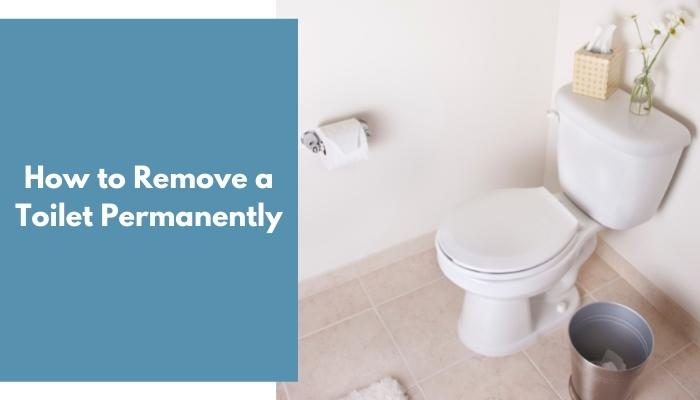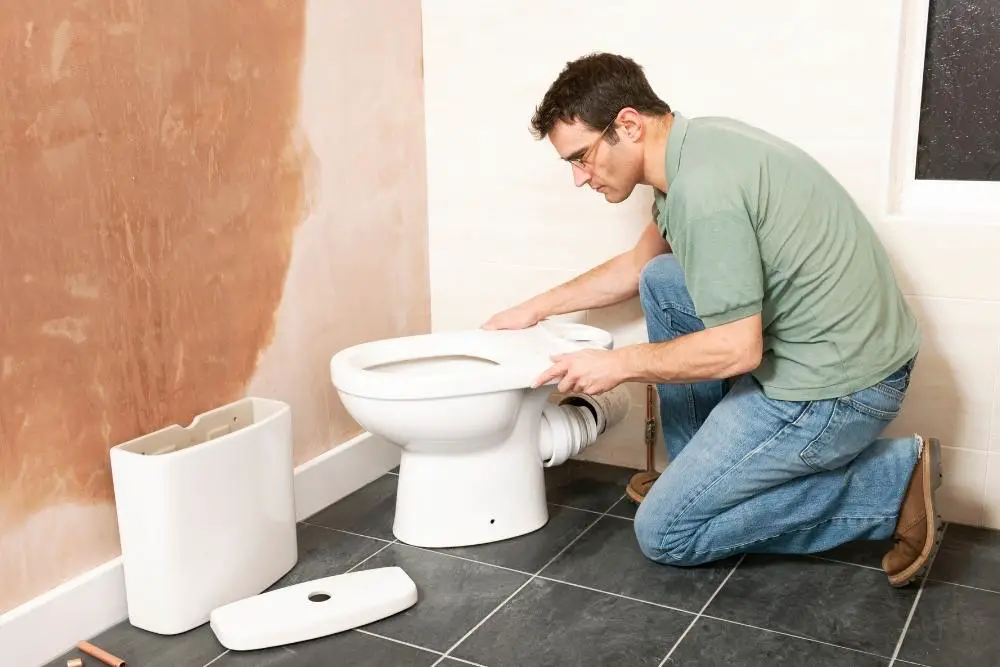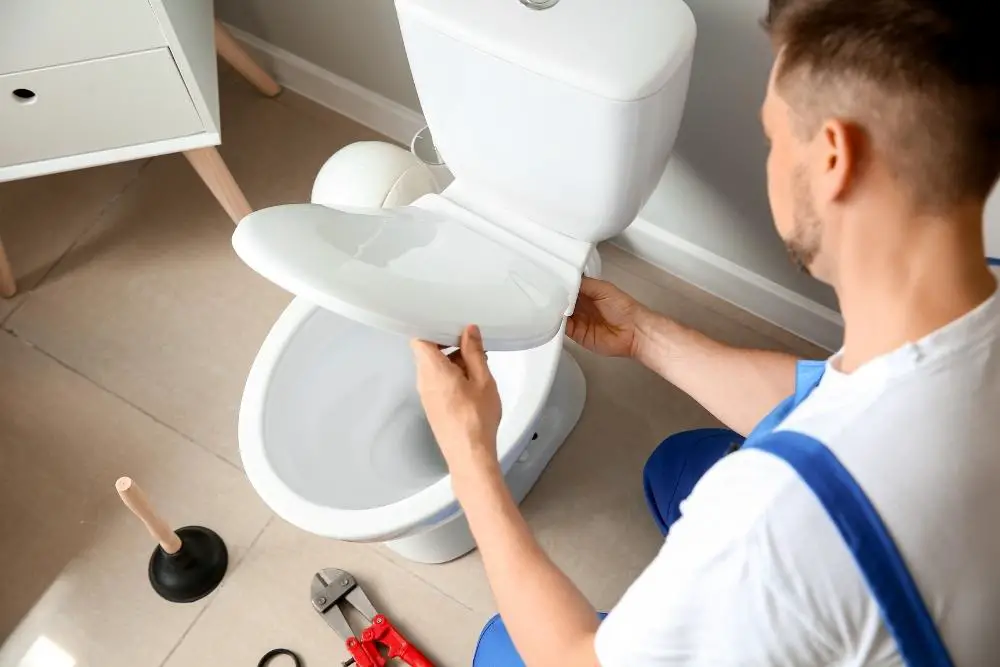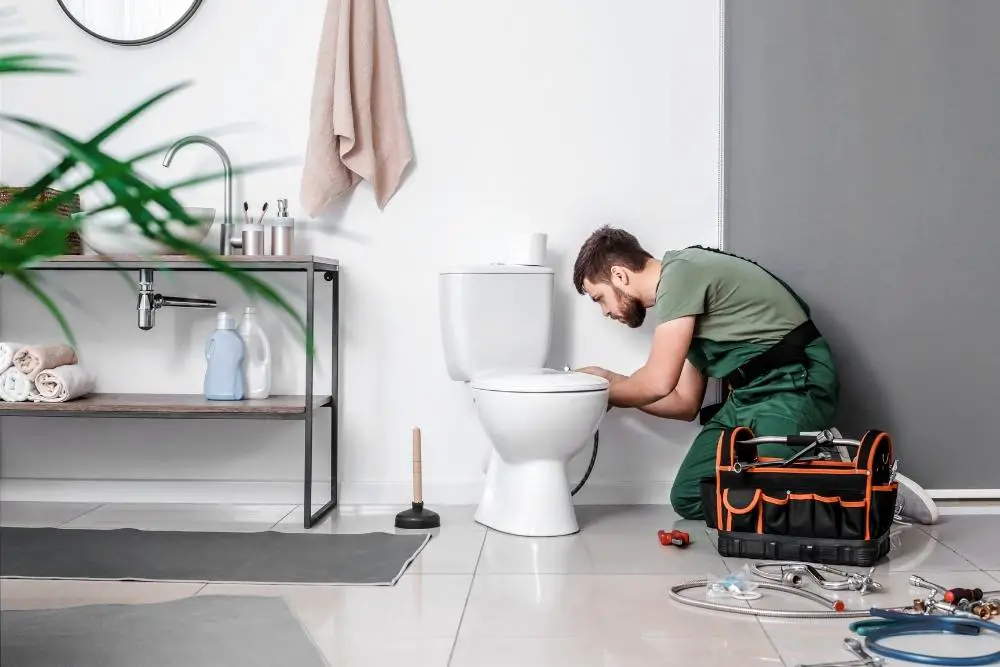There are many reasons to remove a toilet bowl. You either want to stop the buildup of sewage, or you need to close off the drain.
To permanently remove a toilet, flush it and close its waterline. Double-check if there are leaks to be concerned about. Then, drag the cap and nuts from its body by lifting it off the floor.
Before proceeding, consult a licensed professional to carry out the job correctly. Capping a drain line is usually done by removing the flange and installing a drain cleanout.
This article will give instructions on how you can remove a toilet permanently.
Contents
- 1 How to Remove a Toilet Permanently
- 1.1 Step 1: Turn Off the Water
- 1.2 Step 2: Flush the Toilet
- 1.3 Step 3: Disconnect the Water Line
- 1.4 Step 4: Loosed the Flange Bolts
- 1.5 Step 5: Remove the Toilet
- 1.6 Step 6: Extract the Toilet Gasket
- 1.7 Step 7: Lodge a Toilet Plug
- 1.8 Step 8: Remove the Toilet Flange
- 1.9 Step 9: Choose the Kind of Drain Cap Needed
- 1.10 Step 10: Install a Permanent Cap or Cleanout
- 2 Things to Remember When Removing Your Toilet
- 3 Can You Close off a Toilet Drain by Yourself?
- 4 Frequently Asked Questions
- 5 Conclusion
How to Remove a Toilet Permanently
Getting rid of a toilet is a standard part of any home renovation. However, it can be challenging and time-consuming to do it properly. In this tutorial, we’ll walk through the steps involved in removing a toilet.
Step 1: Turn Off the Water
Before working on this task, make sure to shut off the water supply to the toilet. It will prevent the pipe from freezing in a power outage.
Not correctly shutting off the water will cause the unpleasant smell of sewage to spread throughout the house. Plus, it’ll take a while to remove the smell once the cleaning is complete.
Step 2: Flush the Toilet
Even though the water supply is not working anymore, your toilet tank will still have plenty of water. To avoid accidentally spilling the water, flush the toilet to empty it. Also, remove the lid to check the water level.
Step 3: Disconnect the Water Line
The water line from the toilet tank is usually attached to a plastic nut. To remove it, loosen the nut by reducing it. When the line is disconnected, the water should not spill. It’s essential to prevent the mess from happening once the tank is empty.
Step 4: Loosed the Flange Bolts
Use a screwdriver to remove the plastic caps from the screws that connect the floor to the toilet. Then, drag the nuts from the exposed screws.
Step 5: Remove the Toilet
You can now easily remove the toilet after removing the nuts from the flanges. To do so, lift the toilet off the floor and set it aside. If the water inside the toilet bowl gets spilled onto the ground, it can cause issues with the drainage system. To prevent this, use rags to remove the water from the bowl.
Step 6: Extract the Toilet Gasket
After removing your toilet, a rubber gasket will remain in place on the toilet’s flange. If you used a wax ring, carefully remove the wax from the toilet’s surface.
Step 7: Lodge a Toilet Plug
After removing the toilet, there will be an open drain. It will allow harmful sewer gas to enter your home. To prevent this, use a drain plug. Before you buy a drain plug, measure the length of your drain pipe to make sure it fits properly. Then, install it by carefully inserting it into the tube.
Before proceeding, make sure that you plug the drain. It’s also important to note to remove the toilet correctly. Follow these steps to seal the drainpipe of your bathroom permanently. A proficient plumber will be able to execute these repairs.
Step 8: Remove the Toilet Flange
To permanently cap a drainpipe or install a new one, you must first remove the toilet flange. This step is significant to avoid damaging the pipe itself.
Step 9: Choose the Kind of Drain Cap Needed
Before installing a drain cap, a professional will first determine if you should cap the drain or if a drain cleanout is needed. A drain cleanout is the most common foolproof method for dealing with blocked drains.
Step 10: Install a Permanent Cap or Cleanout
Before adequately cleaning out your drain, a professional will need to fit a drain cap or cleanout pipe. A drain cap is a protective device that can prevent sewer gas from entering your home.
It is not safe to cap or cover a drain yourself, and it is also not advisable to build over it if it has not been done so by a professional.
Things to Remember When Removing Your Toilet
These are some standard reminders that homeowners forget when tackling a home improvement project. Doing so can quickly create a mess and cause the smell to remain in the house for a long time.
Do Not Rock the Toilet Too Much
Doing too much rocking the toilet can cause water to seep into the pipes. This water will then generate a long-lasting stench.
Inspect the Threads Inside the Flange
If the inside of the flange does not have threads, then a different cap is required to close the drain. Most of the time, a good fit is created using a rubber plug. However, some are made with wood and require hitting the top of the plug to install fully.
Wear Gloves
When cleaning and preserving the tubes and toilets, it’s essential to keep them safe from germs and contaminants. It would be best to use gloves to protect you from these hazards.
Can You Close off a Toilet Drain by Yourself?
Getting dirty with pipes can be a bit of a mess, especially if you’re not careful. Those who are sensitive to unpleasant smells may want to avoid this job.
This simple task will require some essential tools and a bit of heavy lifting. If you cannot lift the toilet itself, you may need the help of a skilled plumber or an extra pair of hands.
It’s impossible to do this job without hiring a professional. However, if you have the necessary skills and experience, it’s also possible to do it yourself.
Frequently Asked Questions
How Do You Remove a Two-Piece Toilet?
You can effectively remove a two-piece toilet by following the same method in removing a single toilet. First, turn off the water, and disconnect the toilet’s connection to the line. Use a towel or bucket to collect the water that may be draining from the line.
Then, unscrew the bolts installed to hold down the bowl. Lastly, gently lift the toilets with the help of someone and seal the drainpipe to prevent gases from pestering the house.
Do You Need to Plug the Drain After Removing the Toilet?
It would be best if you plug the drain after removing the toilet. After removing the toilet, you will need to connect the drainpipe to avoid getting gases and other things into the tube. Wear your masks when you’ve decided to do this on your own.
Hiring an expert is still the most recommended step to avoid further damage.
How Do You Remove a Floor-Cemented Toilet?
To remove a floor-cemented toilet, you need to crack down the cement using various tools before lifting the toilet bowl and draining the pipe. To remove a pan from its waste pipe, remove the pan’s back portion using a small hammer and a chisel.
Then, use an enormous hammer to break the pan away from the line. Y ou might need a professional when doing this one.
Do You Have to Replace the Wax Ring When You Remove a Toilet?
Yes, you need to replace the wax ring seal for safety when removing a toilet. This component can prevent mold and bacteria from forming inside the toilet. Wax rings ensure that there will be a separation between the drain pipe and your house.
It means that the toxic sewer gases will not be able to penetrate your home and cause diseases to everyone living there.
How Do You Drain Water From Toilet Bowl?
Before removing it, you only need to follow a few steps to drain water from a toilet bowl—first, turn off the toilet’s cut-off valve. After draining the tank, flush the toilet using the handle down until removing all its water.
Ensure that there will be no splashes later on while removing the toilet itself. You can also pour a water-filled pale or basin into the bowl to ensure that you will flush all the water.
Conclusion
A skilled professional will need to be able to cap the line. However, removing the toilet and plugging the drain line makes it more manageable for the professionals who will later polish your process.
To remove the toilet: Flush the toilet first. Then, unscrew the bolts and remove the nuts from the bathroom. Position the toilet on the floor and lift it off the flange.
Before proceeding with the toilet removal, you must hire a professional to help you permanently cap the drain. It involves removing the pipe’s flange and fitting a cap.







